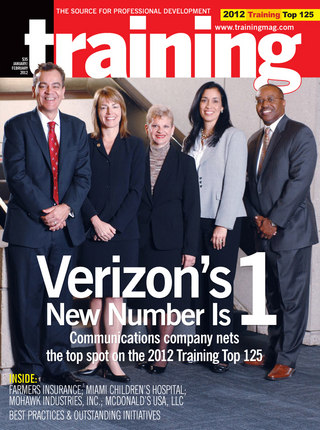Home January / February 2012
The 2012 Training Top 125
The best learning and development organizations support business initiatives tactically and help drive strategic change. Verizon did just that, earning it the No. 1 spot for the first time on the Training Top 125. Verizon and the other 2012 Top 125 winners continued to invest in training, collectively dedicating a mean of 4.52 percent of their payroll to the training budget. Some 24 newcomers earned a spot on the list this year, the 12th in a row Training has ranked the top companies of employer-sponsored workforce training and development.
Best Practices and Outstanding Initiatives
BEST PRACTICES
Edward Jones: Practice Makes Perfect (Sales Training)
Each month, Edward Jones hires more than 150 new recruits with little financial background, then trains them to serve clients well. This organic growth is achieved through extensive training, including coaching by veterans, online study, virtual classes, weeklong stints of classroom training, and recorded role-play.
Mohawk Maximizes Learning
By Margery Weinstein
A Higher Calling
Verizon rang in the New Year with a new number: The telecom company earned the No. 1 spot on the 2012 Training Top 125. Farmers Insurance claimed the No. 2 spot, while Top 5 newcomers Miami Children’s Hospital, Mohawk Industries, and McDonald’s nabbed Nos. 3, 4, and 5, respectively.
Some 24 new companies broke into the Top 125 this year, with Capital One and Sprint Nextel Corp. debuting in the Top 50. The majority of the companies are in the health/medical services, real estate/insurance, business services, and finance/banking industries.
Soapbox: ROE: Demonstration of Training Value
Return on expectations (ROE) is a foolproof way to show the value of training in the terms desired by key stakeholders. ROE demonstrates the degree to which training initiatives satisfy the expectations of key business stakeholders. Assumptions that may assist training professionals include:
Key stakeholders are high-level managers or executives.
Stakeholder expectations primarily include the accomplishment of the organization’s highest-level goals and mission.
Figure 1: The Kirkpatrick Model
How-To: Motivate, Engage, and Involve Your Team
By Brad Karsh
It is no easy task to motivate, engage, and involve your team, and it certainly doesn’t happen overnight. Even today’s most prominent business tycoons admit the most difficult part of their job is managing and leading their people. Take the late Steve Jobs, for instance. Jobs obviously made extraordinary contributions at Apple, but he spoke openly about his struggles in his role as CEO. Jobs learned from mistakes, and his analogy for what builds strong businesses was spot on:
World View: Focus on Republic of Singapore
By Jessie Lee Mills
Best Practices: T&D for Global JVs and M&As
By Neal Goodman, Ph.D.
Between 50 and 70 percent of international joint ventures (IJVs) fail, yet the number of IJVs, mergers, and acquisitions continues to increase. It is estimated that companies are making a combined investment of upward of $500 billion a year in these high-risk/high-reward ventures. What must not be overlooked is the role Training and Development can play in increasing the likelihood that these ventures will be more rewarding and less risky. Here is one current example:
Training magazine Events: Let’s Do It!
By Tony O’Driscoll
At the Training 2012 Conference, we gathered to celebrate the 35 years we have spent together as a community of committed and capable learning professionals tirelessly dedicated to understanding how to leverage human capital to drive business results.
Trainer Talk: 6 Magic Training Phrases
By Bob Pike
I worked in Australia, Japan, and China for most of November last year. In seminars in each of those countries I asked participants to create a list of what I call “magic phrases” during the training. These are short phrases that capture the essence or “magic” of a key training concept.


